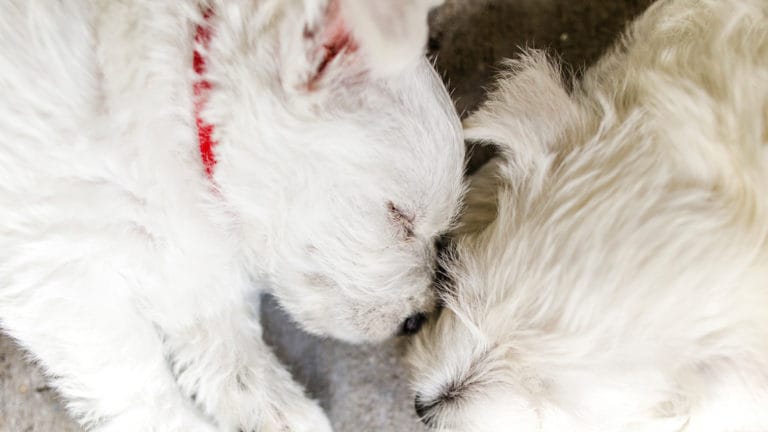The promise of an adorable litter of puppies is enough to make anyone’s heart swell. Think of it now: sweet faces and tiny barks, wee-sized bodies and silly behaviors. No doubt your mama pooch is hard at work building her pups, but do you know what to expect during this gestation period as a dog parent?
From determining whether your pup is for sure preggo and knowing the length of time of dog pregnancy (it’s shorter than you may think!) to learning how to care for your pregnant pooch throughout her stages of pregnancy, we’re outlining everything pet parents need to know.
In This Guide:
How Long Are Dogs Pregnant? The Typical Dog Gestation Period
The average gestation period for dogs is 63 days, or about 2 months, says Dr. Erin Katribe, DVM, a Richmond, Texas-based veterinarian and medical director for Best Friends Animal Society, an animal welfare organization.
“This time period is measured from ovulation—which is when eggs are released from the ovaries,” Dr. Katribe says. “A dog may give birth anywhere from 58 to 68 days after breeding.” This timeline is true for all dog breeds.
How Vets Determine When a Dog Is Pregnant
Determining whether your pup is pregnant is a little tricky in those early weeks of pregnancy. It really isn’t until around the third week that signs of pregnancy start to appear. Even then, they’re pretty subtle.
“About three weeks into pregnancy, a pregnant dog may experience a little nausea, gastrointestinal upset and appetite loss, similar to morning sickness in humans. This should only last a week or so,” says Dr. Andrew Heller, DVM, a Delray Beach, Florida-based veterinarian and the co-founder of IndeVet. “Physical changes don’t usually become evident until the second half of pregnancy.”
That said, if you suspect your dog is pregnant, then at around three or four weeks of pregnancy you can schedule a veterinary appointment for a definitive answer. Your vet has a handful of tools and tests they can use to determine whether your pup is, in fact, carrying puppies. These include:
- Dog pregnancy test: Around 21-30 days after conception, your vet can administer a pregnancy test to determine whether your pup is pregnant. This blood test looks for the hormone relaxin, which is released by the placenta only in pregnant dogs, Dr. Heller explains.
- Abdominal ultrasound/physical exam: At around 21-30 days, your vet should be able to confirm fetuses inside of your dog’s womb via imaging; and at 24-35 days, palpation (manual examination by touch) can be used as well.
- X-rays: “X-rays can detect fetal skeletons at 43-45 days in, but most [veterinarians] will wait until after day 50 just to be sure,” Dr. Heller says. This is an important test because it helps you determine the litter size, which comes in handy as you prepare your pup for whelping (labor).
Signs of Dog Pregnancy
The most common sign of dog pregnancy that pet parents recognize is abdominal swelling, but this isn’t the only sign to look for, Dr. Katribe says. “When this becomes noticeable is extremely variable,” she adds, “and not typically until around five to six weeks into pregnancy.”
Some additional dog pregnancy signs to look for include:
- Behavior changes: Be on the lookout for a subtle change in typical behavior, such as a “little laziness or extra affection for their human family,” Dr. Heller says.
- Appetite shifts: Your pup may experience a quick phase of morning sickness in their early pregnancy, which can cause appetite changes.
- Vomiting: Morning sickness can also cause your pup to experience mild vomiting.
- Weight gain: “As the pregnancy moves on, you will notice weight gain,” Dr. Heller says. This gain is focused primarily around the abdomen.
- Nipple changes: Around five to six weeks of pregnancy, a dog’s nipples may become larger, darker and more prominent. Over time, they may also become more pink due to increased blood flow to the area.
- More urination: Your dog may drink more water during pregnancy and pee more frequently, Dr. Heller notes.
- Nesting behavior: In the later stages of pregnancy, dogs may exhibit nesting behavior, such as rearranging bedding or searching for a quiet, comfortable place to give birth.
- Visible puppy movements: As your dog’s due date approaches, you may be able to see the puppies moving around in your dog’s abdomen, similar to seeing or feeling a human baby “kick,” Dr. Heller says.
Fun fact: More than 70 percent of fetal growth occurs after the first five weeks of pregnancy, and you’ll notice very little weight gain before you get to week five.
Dog Pregnancy: Week by Week
Weeks 1-2
After fertilization, pregnant dogs begin developing a placenta and amniotic sac for developing embryos (soon to be newborn puppies). You likely won’t notice much difference in your pup yet.
Weeks 3-4
About three weeks into pregnancy, a pregnant dog may experience some nausea, GI upset and appetite loss, similar to morning sickness in humans. This should only last a week or so.
Weeks 5-6
At around the halfway point of your dog’s pregnancy, their appetite should normalize. You may start to notice a bigger belly, and your dog’s mammary glands (teats/nipples) will swell and discolor. The last several weeks of pregnancy is when you’ll notice a 15-25 percent weight gain, mainly around the abdomen.
Week 7
She may start to shed fur around her belly in the mammary area.
Week 8
You may notice colostrum (early milk) drip from her teats. You may also notice puppy-related movement in her distended abdomen.
Week 9
Your pregnant dog may be feeling uncomfortable, as she’s ready to go into labor/whelping. She may show signs of anxiety and nesting. Vaginal discharge is normal but should be clear to white and relatively odorless.
How To Prepare for Whelping (Or Puppy Birthing)
As you approach the final weeks of your dog’s gestation period, it’s important to prepare for whelping, also known as labor or birthing.
Know the Litter Size
Knowing the number of puppies your dog is carrying helps pet parents and veterinarians properly care for the mother dog. It can also help prepare for the whelping process by ensuring a suitable birthing environment and sufficient resources for all those newborn puppies.
Isolate Your Pup
It’s important to give your pregnant dog some space of her own, away from other animals and major traffic. “To prevent viral infection with canine herpesvirus during the latter part of the pregnancy, the mother should be kept away from all other dogs during the three weeks leading up to birth and the three weeks following birth,” Dr. Katribe advises.
Provide a Whelping Box
As your pup approaches whelping, it’s important to provide her with an appropriate environment that’ll be safe for both mother and the puppies, notes Dr. Katribe. This should be a private, quiet, comfortable and warm space with clean bedding. Make sure to also provide easy access to food and water.
Note that inappropriate enclosures can be dangerous for newborn puppies, so this should be a safe space for them, too. Unsafe spaces include cold or drafty areas, crowded or high-traffic rooms, places with excessive noise, and environments lacking adequate cleanliness.
Take Her Temperature
A pregnant dog’s body temperature drops about one or two degrees 24 hours prior to giving birth (from about 101-102.5°F to 98-99°F), Dr. Heller says. “It’s OK to take a rectal temp every day during the ninth week of pregnancy, so you can be ready for her labor,” he adds.
How Long Are Dogs in Labor?
On average, the active stage of dog labor lasts 6-12 hours. However, just as is the case for humans, labor can be shorter or longer. There are three primary stages of labor:
Stage 1Contractions and Dilation
In this first stage, your dog will experience uterine contractions, and her cervix will completely dilate. “She will become restless and anxious and her nesting behavior will begin where she will drag clothing or fabric into her whelping area to create a comfortable bed. She may shiver, pant and even vomit,” Dr. Heller says.
Stage 2Birthing of the Fetuses
Bring on the newborn puppies! During stage two, abdominal contractions will start to become intense. The birth of the first puppy should occur within one to two hours after these contractions begin. She may rest in between birthing, but each pup should be born at least every two to three hours. Anything longer than that should prompt veterinary care.
Stage 3Placenta Expulsion
In the third stage of dog labor, your pup will expel her placentas.
She will have one placenta for every puppy, which usually expels 15 minutes after the pup is born. (Dr. Heller notes that sometimes more than one pup is born at a time, and then more than one placenta expelled.)
It’s crucial to keep track of how many placentas come out in total and to make sure there’s one placenta per pup. Retained placentas can lead to complications. After each placenta is expelled, it’s back to stage two when another puppy is on their way out.
Possible Dog Labor Complications
Complications related to labor, delivery and in the first few weeks of life are not uncommon in dogs, and these complications can be fatal for the mother and/or the puppies, Dr. Katribe says. In addition, these complications can lead to high emergency care costs.
Such complications include:
- Retained placenta
- Excessive bleeding
- Uterine torsion (rotation)
- Pregnancy toxemia (blood sugar drops)
- Eclampsia (weakness and possible seizures due to low blood calcium levels during pregnancy or after birth)
- Gestational diabetes
- Dystocia (when a puppy is stuck in the birth canal)
- Mastitis (inflammation of the mammary glands)
“If a dog is bred unintentionally, consult with a veterinarian right away to determine if there are alternative options to allowing her to go to term,” Dr. Katribe says. “This can protect her from serious pregnancy complications and avoid costly veterinary bills for emergency care.”
Dr. Katribe adds that many dogs are still being killed in shelters across the country simply because there are not enough homes. For this reason, she strongly advocates spaying and neutering your animals.
How Pet Parents Can Care for a Pregnant Dog
When caring for a pregnant dog, our veterinarian experts recommend the following:
- Take regular walks to keep your pup in good health—but avoid stressful training.
- Feed her a high-quality, balanced diet and increase her calories closer to her due date. (You can increase the calories by 25-30 percent in the final three to four weeks.)
- Treat the mother with a daily dewormer for parasite control, starting at day 40 until 14 days post parturition (period following whelping), and to isolate your pup from other animals in the latter half of her pregnancy. Note that vaccinations aren’t generally given to pregnant dogs, so it’s important that your pet receives vaccinations prior to becoming pregnant.
Check in as needed with your veterinarian to ask questions and to have your pup examined throughout her pregnancy.
Bringing a new litter of puppies into the world is exciting, whether it’s your first time as a pet parent or you’re an experienced breeder! Prior to that big day, make sure you’ve dotted all your i’s—all outlined above—so your dog can safely navigate her pregnancy and labor. Also, make sure you’ve got a plan of action for those newborn puppies, including care, rehoming and puppy training.
Expert input provided by Dr. Erin Katribe, DVM, a Richmond, Texas-based veterinarian and medical director for Best Friends Animal Society, an animal welfare organization; and Dr. Andrew Heller, DVM, a Delray Beach, Florida-based veterinarian and the co-founder of IndeVet.
This content was medically reviewed by a veterinarian.
Share:









